The Role of Ferrochrome in Stainless Steel Production

Ferrochrome, an alloy of chromium and iron, is a crucial component in the production of stainless steel. It not only enhances the strength and corrosion resistance of steel but also plays a vital role in various industrial applications. This post explores the importance of ferrochrome, its production process, and its impact on stainless steel manufacturing.
What is Ferrochrome?
Ferrochrome is an alloy consisting of chromium (between 50% and 70%) and iron. It is primarily produced in electric arc furnaces and is used extensively in the metallurgy of stainless steel.
Uses of Ferrochrome in Stainless Steel Production
Ferrochrome is essential in the production of stainless steel due to its unique properties and characteristics. Here are the primary uses of ferrochrome in this context:
1. Enhancing Corrosion Resistance
Ferrochrome is rich in chromium, which is the key element that provides stainless steel its corrosion-resistant properties. By adding ferrochrome during the steelmaking process, manufacturers can produce stainless steels that withstand harsh environments, including moisture, chemicals, and high temperatures.
2. Improving Strength and Durability
The addition of ferrochrome contributes to the overall strength and toughness of stainless steel. This is particularly important in applications where structural integrity is critical, such as in construction, automotive, and aerospace industries.
3. Facilitating Alloy Production
Ferrochrome is often used to create various stainless steel grades, each tailored for specific applications. For example:
- Austenitic Stainless Steels: Ferrochrome is added to achieve high strength and ductility.
- Ferritic Stainless Steels: It helps improve formability and oxidation resistance.
- Martensitic Stainless Steels: Ferrochrome enhances hardness and wear resistance.
4. Maintaining Steel Purity
In the production of low-carbon stainless steels, low carbon ferrochrome is used to ensure that the final product has minimal carbon content. This is crucial for applications requiring high purity, such as in food processing and pharmaceuticals.
5. Cost-Effectiveness
Using ferrochrome allows steel manufacturers to optimize their processes, balancing performance and cost. As ferrochrome is a relatively affordable alloying material compared to pure chromium, it helps keep production costs in check while still delivering high-quality stainless steel.
6. Application in Specialty Alloys
Beyond stainless steel, ferrochrome is also used in the production of other specialty alloys that require enhanced properties, such as high strength and resistance to wear and heat.
Importance of Ferrochrome in Stainless Steel
- Corrosion Resistance: The addition of chromium from ferrochrome enhances the corrosion resistance of stainless steel, making it suitable for a wide range of applications, from kitchen utensils to industrial machinery.
- Strength and Durability: Ferrochrome improves the mechanical properties of steel, providing greater strength and toughness.
- Heat Resistance: Stainless steels with high chromium content maintain their strength at elevated temperatures, making them ideal for high-heat applications.
Types Of Ferrochrome in Stainless Steel Production
- High Carbon Ferrochrome (HCFeCr): Contains about 6-8% carbon and is the most common form used in stainless steel production.
- Low Carbon Ferrochrome (LCFeCr): Contains less than 0.15% carbon and is used in applications requiring low carbon content to maintain the purity of stainless steel.
- Medium Carbon Ferrochrome (MCFeCr): Contains 0.5-3% carbon and is used for specific stainless steel grades.
Production Of Ferrochrome in Stainless Steel Production
- Raw Materials: The primary raw materials for ferrochrome production include chromite ore, coke, and limestone.
- Smelting Process:
- Electric Arc Furnace (EAF): Chromite ore is mixed with coke and limestone and then smelted in an EAF at high temperatures (around 1,600 °C).
- Reduction Reaction: During the smelting process, the chromium in the ore is reduced, resulting in the formation of ferrochrome.
- Refining: The molten ferrochrome is refined to achieve the desired composition, including the removal of impurities.
Application Of Ferrochrome in Stainless Steel Production
- Blending: Ferrochrome is added to molten steel during the stainless steel manufacturing process.
- Alloying: The chromium from ferrochrome combines with iron, creating a stainless steel alloy with enhanced properties.
- Grades of Stainless Steel: Different grades of stainless steel require varying amounts of ferrochrome, depending on the desired characteristics.
Environmental Considerations Of Ferrochrome in Stainless Steel Production
- Sustainability: The production of ferrochrome involves energy-intensive processes, leading to a focus on developing more sustainable practices.
- Recycling: Stainless steel is highly recyclable, which helps reduce the environmental impact associated with mining and processing raw materials.

